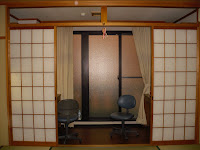First, there is this twice folded mattress. You just lay it out.
Next you put another thick, but soft mattress over it.
Cover it up with a sheet.
Next, you put the comforter inside of a sheet that has a hole in it. Why does it have a hole in it? I'm not really sure. . .
Finally, you stick a warm, soft blanket inside of the hole. I actually wouldn't mind just cuddling up with that blanket, but I think this is the way it is supposed to go. Add a pillow and some pajamas for optimal comfort levels.
The classes I have signed up for are different from the one's I thought I'd be taking. The culture class I wanted to sign up for wasn't available this semester, so I have revamped my schedule. After testing, I have entered Japanese Speaking 4 (sounds right) and Japanese Reading and Writing 4 (Might not be right, but I think I'll just go with the flow). I also got into The Body and Communication in Japan, Japan in Western Film and Literature, as well as the Sumi-e class that I really wanted to get into!!
Here are some course descriptions.
The Body and Communication in Japan
Dr. Steven C. Fedorowicz
Gestures, sign languages, postures and perceptions of the body are not
universal. So-called nonverbal communication, associations between the
body and linguistic meaning differ from culture to culture. A hand-shape in
one country can be very offensive in another. The image of an attractive body
in one country can be very different from that of another country and thus
convey very different intentional and unintentional messages. This class will
explore these issues in the Japanese context. Lectures, in-class discussions,
activities and readings will deal with gestures and facial expressions that play
important roles in interpersonal communication, rituals and entertainment.
Japanese Sign Language and its importance to Deaf culture will be a major
focus. Finally, the body itself, images of the body and how the body is
modified and decorated will also be explored. Objectives of this course are 1)
exploring the relationship between gesture and language, 2) gaining a better
understanding of the role of the body in communication, and 3) improving
cross-cultural communication skills.
Course Topics
1. Japanese Sign Language and Deaf Culture
2. Japanese gestures
3. Emotion and facial expressions
4. Japanese theatre and dance
5. Japanese martial arts
6. Mudra, gestures and dance in Japanese religion
7. Jan-ken and hand games
8. Japanese perceptions of the body and ideal body types
9. Molding the body – fad diets and exercise
10. Portrayals of the body in advertising and the media
11. Ornamenting the body – fashion
12. Ornamenting the body – tattoos and body pierces
---------------------------------------------------------
Japan in Western Film and Literature
Dr. Mark Hollstein
Why come all the way to Japan and take a course on how foreigners see the
Japanese? The answer is simple. Whether you make interpreting Japan an
academic, journalistic, or artistic career, or just answer questions from
friends and family about your experiences here, someday you will be called
upon to explain Japan to non-Japanese. This course will help you understand
how those who have gone before you have both succeeded and failed at this
task from 1853 to the present day. A central concern of this course is why
filmmakers and authors have emphasized, exaggerated, distorted or ignored
various aspects of Japanese culture to meet the expectations of their
audiences, and the way in which images of Japan, constructed in response to
specific historical situations are often recycled to justify or explain later
situations. We will also consider how changes in Western class, gender and
race relations have influenced media images of the Japanese Other. By the
end of this course, you should have both a good understanding of modern
Japanese history and a clearer idea of how group identity is created and used.
You will also be a more aware and critical media consumer.
Course Topics
(Some films will be viewed in their entirety, other by selected scenes)
The Topsy-Turvy Alien Japan
Authors: Percival Lowell, Walt Whitman, Rudyard Kipling
Films: The Barbarian and the Geisha; Lost in Translation
Japanese as Artists, and Mystics
Authors: Lafcadio Hearn
Films: Gilbert and Sullivan’s The Mikado; Topsy-Turvy;
Enlightenment Guaranteed
Japanese as Villains and Enemies
Films: The Cheat; Broken Blossoms; Know Your Enemy, Japan;
Why We Fight, The Battle of China; Bugs Bunny Nips the Nips;
Popeye’s You're a Sap Mr. Jap
Japanese as Victims
Authors: Marguerite Duras, Jeanne Wakatsuki Huston, John Hersey
Films: Come See the Paradise; Hiroshima Mon Amour
Western Images of Postwar Japanese Women
Authors: James Michener
Films: My Geisha; Sayonara
Japanese as Corporate Samurai
Authors: Ian Fleming, Michael Crichton, Amelie Nothomb
Films: Black Rain; Rising Sun; Fear and Trembling
-------------------------------------------------------------
Japanese-Chinese Brush Painting
(Sumi-e)
Ms. Kathleen Scott
This studio course is designed to introduce students to the basic techniques
of Japanese-Chinese monochromatic ink painting. Material specific to this
medium are introduced and include various papers, inks, and brushes.
During the first half of the semester, traditional flower motifs (bamboo,
orchid, plum, and chrysanthemum) are used as points of departure. The
latter half of the course is devoted to the compositional principles and brush
techniques involved in Japanese-Chinese landscape painting, (J., sansui-ga).
Five hours of studio time are supplemented by a minimum of three hours of
individual work. Students are required to display one of their final works in
an exhibition at the end of the semester.
Classes meet three times a week, and one of these meetings is considered the
primary teaching day. New material is introduced and techniques applied.
Due to the importance of this first teaching day, in order to enroll in sumi-e,
students must be able to arrange their schedules to fit into one of the teaching
blocs. The remaining schedule will be arranged according to priorities.
.JPG)
.JPG)
.JPG)
.JPG)



























































